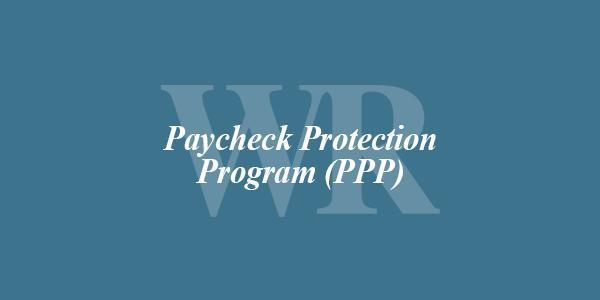
Work Opportunity Tax Credit Extended Through January 1, 2026
January 22, 2021
Healthcare Update – Provider Relief Fund (PRF) Portal is Open, But…
January 22, 2021PPP Update: Second Draw PPP Loans

The SBA today released information on how to calculate revenue reduction and maximum loan amounts for Second Draw PPP loans, including what documentation to provide with the application. Below we highlight some key elements of this along with eligibility requirements for these loans. The SBA Portal to accept these second draw applications is expected to be open to all lenders today. If you believe you will qualify, reach out to your bank to see if their application process is open. We are also here to help you through this process. If you need assistance or guidance, reach out to your WR Partner, your WR relationship manager, or you can email our COVID-19 task force.
Maximum Loan Amount
Equal to 2.5 times the company’s average monthly payroll up to $2 million. (3.5 times average monthly payroll for business with NAICS codes starting with 72, like hotels and restaurants.)
Borrower Eligibility Requirements
- 300 or fewer employees
- Experienced a revenue reduction of 25% or greater in any quarter of 2020 relative to the same quarter of 2019
- Received a first draw PPP loan that was fully used on qualified expenses by the expected date of the second PPP loan funds
Gross Receipts
For a for-profit business, gross receipts generally are all revenue in whatever form received or accrued (in accordance with the entity’s accounting method, i.e., accrual or cash) from whatever source, including from the sales of products or services, interest, dividends, rents, royalties, fees, or commissions, reduced by returns and allowances but excluding net capital gains and losses. These terms carry the definitions used and reported on IRS tax return forms.
Gross receipts do not include the following:
- taxes collected for and remitted to a taxing authority if included in gross or total income, such as sales or other taxes collected from customers (this does not include taxes levied on the concern or its employees);
- proceeds from transactions between a concern and its domestic or foreign affiliates;
- amounts collected for another by a travel agent, real estate agent, advertising agent, conference management service provider, freight forwarder or customs broker; and
- first draw PPP funds.
All other items, such as subcontractor costs, reimbursements for purchases a contractor makes at a customer’s request, investment income, and employee-based costs such as payroll taxes, may not be excluded from gross receipts.
Documentation Needed to Substantiate Reduction
The following are the primary sets of documentation Applicants can provide to substantiate their certification of a 25 percent gross receipts reduction (only one set is required):
- Quarterly financial statements for the entity. If the financial statements are not audited, the Applicant must sign and date the first page of the financial statement and initial all other pages, attesting to their accuracy. If the financial statements do not specifically identify the line item(s) that constitute gross receipts, the Applicant must annotate which line item(s) constitute gross receipts.
- Quarterly or monthly bank statements for the entity showing deposits from the relevant quarters. The Applicant must annotate, if it is not clear, which deposits listed on the bank statement constitute gross receipts (e.g., payments for purchases of goods and services) and which do not (e.g., capital infusions)
- Annual IRS income tax filings of the entity (required if using an annual reference period). If the entity has not yet filed a tax return for 2020, the Applicant must fill out the return forms, compute the relevant gross receipts value (see Question 5), and sign and date the return, attesting that the values that enter into the gross receipts computation are the same values that will be filed on the entity’s tax return.
LINK: Second Draw PPP Application
If you have questions or would like to strategically discuss your situation relative to any of these items, we are here to help. Reach out to your WR Partner or your relationship manager. You can also email our COVID-19 task force for assistance.


